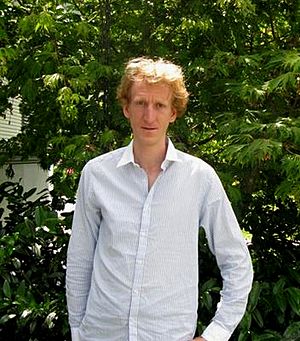Ben Green (mathematician) facts for kids
Quick facts for kids
Ben Green
|
|
|---|---|

Green in 2010
|
|
| Born |
Ben Joseph Green
27 February 1977 Bristol, England
|
| Alma mater | Trinity College, Cambridge (BA, MMath, PhD) |
| Awards | Clay Research Award (2004) Salem Prize (2005) Whitehead Prize (2005) SASTRA Ramanujan Prize (2007) EMS Prize (2008) Fellow of the Royal Society (2010) Sylvester Medal (2014) Senior Whitehead Prize (2019) |
| Scientific career | |
| Fields | Mathematics |
| Institutions | University of Bristol University of Cambridge University of Oxford Princeton University University of British Columbia Massachusetts Institute of Technology |
| Thesis | Topics in Arithmetic Combinatorics (2003) |
| Doctoral advisor | Timothy Gowers |
| Doctoral students |
|
Ben Joseph Green is a British mathematician. He was born on February 27, 1977. He is known for his work in combinatorics and number theory. These are branches of mathematics. He is currently a professor at the University of Oxford.
Contents
Early Life and School
Ben Green was born in Bristol, England. He went to local schools there. He loved math from a young age. He even competed in the International Mathematical Olympiad in 1994 and 1995. This is a big competition for young mathematicians.
In 1995, he started studying at Trinity College, Cambridge. He earned his first degree in mathematics in 1998. He was even named "Senior Wrangler," which means he was the top math student in his year. He continued his studies and earned his PhD in 2003. His PhD supervisor was Timothy Gowers, another famous mathematician.
After his studies, Ben Green worked at several top universities. These included the University of Bristol and the University of Cambridge. Since 2013, he has been a professor at the University of Oxford. He also spent time as a visiting student and researcher at places like Princeton University and Massachusetts Institute of Technology.
Amazing Math Discoveries
Most of Ben Green's research is in analytic number theory and additive combinatorics. These fields explore the properties of numbers and how they combine. He has also worked in other areas of math.
The Green–Tao Theorem
One of Ben Green's most famous discoveries is the Green–Tao theorem. He proved this with his friend and fellow mathematician, Terence Tao. This theorem shows that you can find very long patterns of prime numbers. These patterns are called arithmetic progressions. For example, 3, 5, 7 is an arithmetic progression of primes. The theorem says you can find such patterns of any length!
Exploring Number Patterns
Ben Green has made other important discoveries in additive combinatorics. He improved earlier results about how numbers combine. He also proved the Cameron–Erdős conjecture. This was about "sum-free sets" of natural numbers. A sum-free set is a group of numbers where if you pick any two numbers from the set and add them, the answer is not in the set.
He also developed a special tool called an "arithmetic regularity lemma." This helps mathematicians understand patterns in large sets of numbers.
Higher Order Fourier Analysis
From 2004 to 2010, Ben Green worked with Terence Tao and Tamar Ziegler. They created a new way to study numbers called "higher order Fourier analysis." This method helps count how many ways numbers can solve certain equations. It's especially useful for understanding prime numbers. This new theory is still being explored by mathematicians today.
Group Theory and Geometry
Ben Green has also worked with other mathematicians on different topics.
- With Emmanuel Breuillard and Terence Tao, he studied "approximate groups." These are sets of numbers that behave almost like mathematical groups.
- With Kevin Ford and Sean Eberhard, he studied the symmetric group. This is about how many ways you can rearrange things.
He also worked with Terence Tao on a problem in combinatorial geometry. They helped solve the Dirac-Motzkin conjecture. This problem is about lines and points. They showed that if you have many points in a flat space, and they are not all on one line, then there must be many lines that pass through exactly two of those points.
Prime Gaps and Ramsey Theory
Ben Green also joined a group of mathematicians including Kevin Ford, Sergei Konyagin, James Maynard, and Terence Tao. They improved our understanding of the gaps between prime numbers. For 76 years, no one had found a better way to estimate the longest gap between primes. Their work changed that.
More recently, Green has looked at questions in "arithmetic Ramsey theory." With Tom Sanders, he showed that if you color a large set of numbers with a few colors, you can always find a special pattern of numbers that all have the same color.
Awards and Honors
Ben Green has received many important awards for his work.
- In 2004, he received the Clay Research Award.
- In 2005, he won the Salem Prize and the Whitehead Prize.
- In 2007, he was awarded the SASTRA Ramanujan Prize.
- In 2008, he received a prize from the European Mathematical Society.
- In 2010, he became a Fellow of the Royal Society. This is a very high honor for scientists in the UK.
- In 2014, he was awarded the Sylvester Medal by the Royal Society.
- In 2019, he received the Senior Whitehead Prize.
He is also a Fellow of the American Mathematical Society since 2012. In 2013, he was chosen to give a special lecture called the Gauss Lectureship by the German Mathematical Society.

